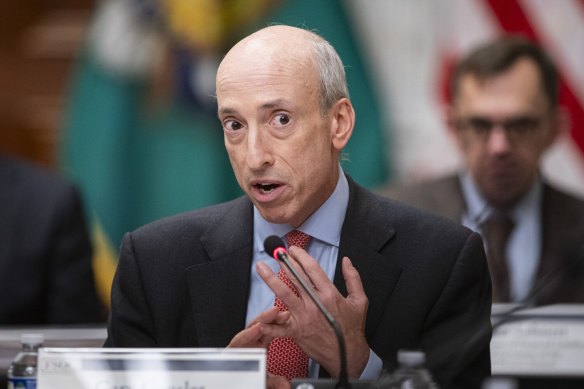
The estimated $US135 million it spent on the election was, it seems, money well spent, with at least 47 of the 56 candidates it backed winning their seats. These include crypto enthusiast Bernie Moreno who, backed by $US40 million of crypto funding, toppled crypto sceptic and chair of the Senate banking committee Sherrod Brown.
The prospect of Gensler being removed has the sector most excited.

SEC chairman Gary Gensler is in Trump’s sights.Credit: Bloomberg
With Congress unwilling or unable to provide a legislative framework for crypto regulation, the SEC under Gensler has filled the vacuum, prosecuting crypto companies for failing to register their platforms or tokens. With other agencies, it has also launched actions against companies for fraud, market manipulation, money-laundering and breaches of US sanctions, and emphasised investor protection over industry development.
Trump has said he will promote policies “written by people who love your industry, not hate your industry” which suggests a far more freewheeling environment for a sector riddled with frauds, thefts and other abuses in recent years.
He and his advisers are already deep into the process of identifying the candidates to lead the key financial agencies, including the SEC, with oversight of the crypto sector.
Cantor Fitzgerald chief executive Howard Lutnick is co-chair of the Trump transition process that is rapidly identifying and nominating candidates for positions in the administration. Lutnick’s company manages more than $US100 billion in US Treasury securities that back the cryptocurrency stablecoin tether.
Tether is reported to be under investigation by the US Treasury for allegedly facilitating transactions for Mexican drug cartels and terrorists but has said it knows nothing about any such investigation.
All the candidates so far named as potential SEC chairs have pro-crypto records. A complication for Trump and the sector is that, while it seems he would have the ability to replace Gensler, he may not legally be able to remove him from the commission before his term as a Senate-confirmed regulator expires in early 2026.
Similarly, Trump’s plan to create a digital currency reserve using the $US12 billion of Bitcoin, ethereum and other cryptocurrencies seized by government agencies comes with significant question marks. The proceeds from sales of those assets have traditionally been used to compensate victims of the crimes, as well as to fund the agencies.
At the more macro level, however, with pro-crypto Republicans soon to be in control of the White House, Senate and probably the House, and the crypto companies already piling up $US78 million of funds for the 2026 midterm elections, it is clear that there will be a dramatic shift in attitude towards the sector.
Responsibility for the sector will probably be shifted to the Commodity Futures Trading Commission, with a “light touch” regulatory mandate. No one in the sector expects anything other than a more deregulatory approach, hence the wild enthusiasm.
It is also conceivable that Congress might make it easier for crypto companies to access mainstream banking services, including bank custodians for their assets, which would give the sector more credibility and greater access to institutional funds.
Any prospect of a Federal Reserve Board-issued central bank digital currency to compete with other cryptocurrencies would disappear.
Trump, who has not shown much understanding of crypto assets, has nevertheless said he wanted them “mined, minted and made in the USA” and that they will “define the future”.
Crypto assets are volatile risk assets that thrive in “risk-on” environments.
Bitcoin mining is notoriously energy-intensive, but Trump has said it will help the US become “energy dominant” because “we will be creating so much electricity that you’ll be saying, ‘Please, please, President, we don’t want any more electricity. We can’t stand it!’” Hmm.
If there is to be a crypto boom in the US, it will need to be better and more consistently regulated than it is today, which will require legislation. Whether it is light-touch regulation or something more black letter in form, at least there would be clearer guidelines for the sector and investors.
Whether the current euphoria continues, of course, is another matter.
Crypto assets are volatile risk assets that thrive in “risk-on” environments, like the post-election enthusiasm that has pushed the US sharemarket up 4 per cent.
Loading
If Trump’s economic plans – his tax cuts, tariffs and deportations – result in a reversal of the current downward trend in the Fed’s (but not the market’s) interest rates, the settings would quickly shift to “risk-off” and the crypto bubble would quickly deflate.
For the excited crypto advocates today, however, that must seem like a distant threat.




























